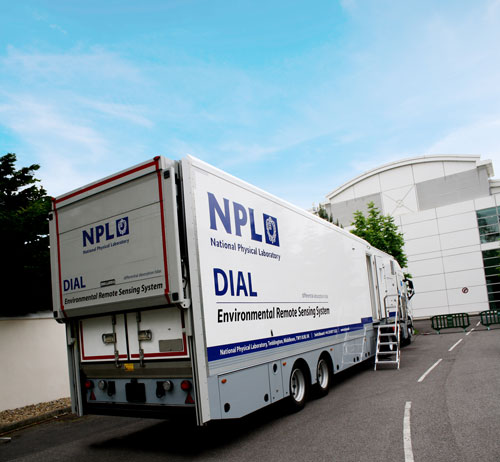The NPL Differential Absorption Lidar (DIAL) is a sophisticated remote sensing system that provides rapid, accurate measurements of airborne pollutants and greenhouse gases (GHGs) following the protocol described in the European Standard EN 17628:2022. The system is a completely self-contained mobile laboratory that provides 3D mapping of emission concentrations and, when combined with wind information, enables quantification of emission rates for a wide range of target species.
DIAL is complimentary to techniques such as Optical Gas Imagining and sniffing (as described in European Standard EN 15446:2008) which identify leaks at component spatial level but are not designed to quantify diffuse emissions over wide areas, such as multiple fugitive emission sources (e.g. leaks), vented emissions or emissions from inaccessible areas such as where local atmospheres are potentially explosive.
DIAL has many advantages over other techniques that are designed to monitor wide areas. DIAL is substantially more flexible than Solar Occultation Flux (SOF), in that it has no need for specific daytime weather conditions or solar position, and it is not dependent on sunlight. DIAL also provides ranged resolved information that allows emissions to be located accurately, and DIAL is much less dependent on making assumptions about the dispersion of emissions compared to techniques such as Reverse Dispersion Modelling (RDM) and Tracer Correlation.
These strengths have been recognised in various publications, include the “Best Available Techniques (BAT) Reference Document for the Refining of Mineral Oil and Gas” (Industrial Emissions Directive 2010/75/EU) where it is referenced as a key method to determine industrial emissions. For more information on the technical specifications of DIAL, please see the document available at the link below.
The DIAL technique has been used for a number of atmospheric monitoring campaigns, including:

If you would like more information about how to access NPL’s DIAL emission monitoring service, please contact us using the link below.
As well as providing DIAL measurement services, NPL has built and provided DIAL systems to support emission monitoring by other organisations. For further information on how NPL can supply a DIAL system for your organisation please contact us using the link below.
Our research and measurement solutions support innovation and product development. We work with companies to deliver business advantage and commercial success.
Contact our Customer Services team on +44 20 8943 7070